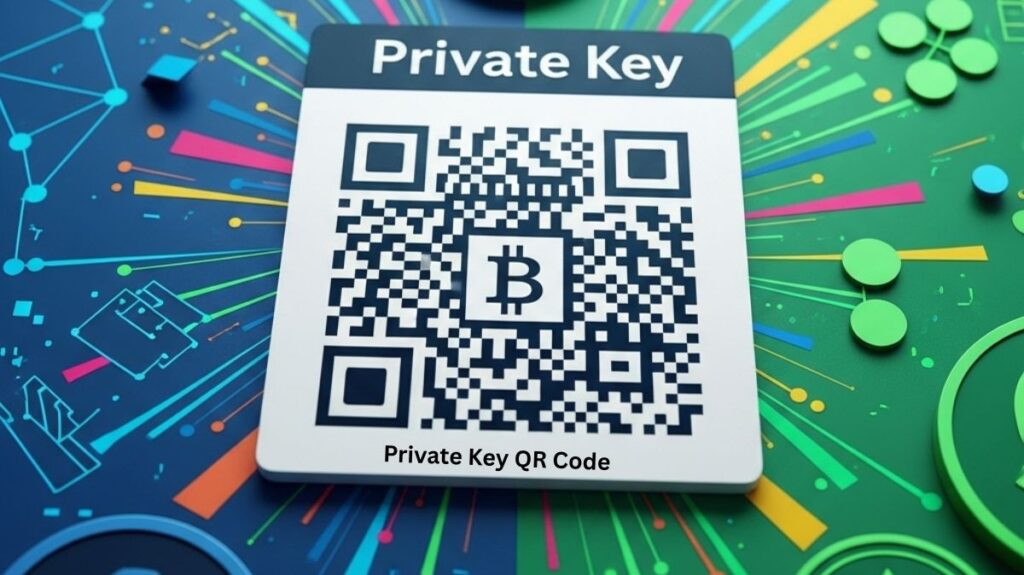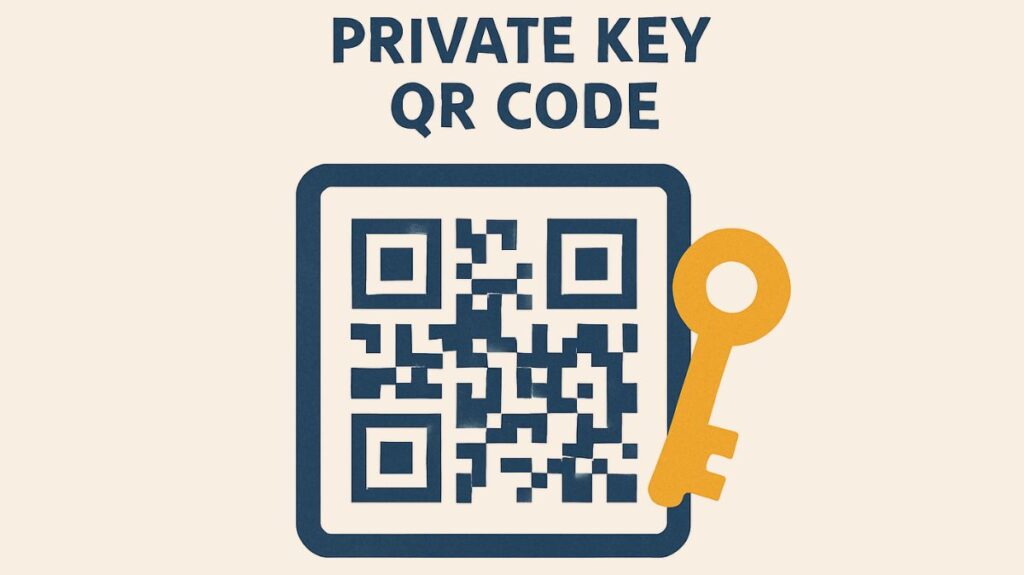Blockchain Private Key QR Code

A machine-readable, scannable version of a cryptographic key is called a Blockchain Private Key QR Code. For users to access and manage bitcoin holdings or communicate with smart contracts, it operates as a secure digital signature. By combining cryptography and fast response code technology, this technology promises to create a safe future by offering a convenient method of managing and using private keys.
What is a Blockchain Private Key?
Private keys are essential to blockchain. Blockchain networks’ cryptographic secrets allow users to safely access and govern their digital assets. Blockchain transactions are identified and signed by a lengthy, random alphanumeric string. It is similar to your cryptocurrency’s secret password.
How a Private Key Works
- It enables consumers to take charge of and manage their digital assets.
- The private key generates a complex cryptographic digital signature at the start of a transaction. This signature proves legal ownership and consent, authenticating the transaction and owner approval.
- It generates unique digital fingerprints (hashes) for each transaction and uses cryptographic hash algorithms to improve security and verification.
- Hardware- or software-based digital wallets store private keys for transactions and security.
- They are part of asymmetric cryptography keys with a public key shared for verification and a private key kept secret. Public keys verify private key digital signatures.
- Access to digital assets is permanently lost in the event that a private key is lost or compromised.
How Does a Blockchain Private Key QR Code Work?
A blockchain private key QR code simplifies the process of storing and using your private key by encapsulating it in a QR code format.
- Encoding: Using specialised software or a QR code generator, the private key a lengthy string of characters is transformed into a QR code format. The text-based key becomes a black-and-white square.
- Storage: Print the QR code (“paper wallet”) or store it as a digital image. Hardware and paper wallets are popular offline security storing techniques.
- Scan QR codes with smartphones or dedicated readers. Very fast compared to manual entry.
- Decoding: The scanner deciphers QR codes and restores private keys.
- Use: Blockchain applications and cryptocurrency wallets can approve transactions, access digital wallets, and prove blockchain asset ownership using the decoded private key.
Blockchain Private Key QR Code Benefits and Importance
Convenience and User-Friendliness
They make blockchain technology easier to use by simplifying private key management. Instantly scanning QR codes to send or receive cryptocurrency enhances user experience. Especially useful for mobile and in-person transactions.
Accuracy and Reduced Human Error
QR codes eliminate the risk of typos, incorrect entries, and other human errors that could compromise accounts or assets when entering long and intricate private keys.
Also Read About Types Of Blockchain Wallets: Hot, Cold, Hardware And More
Enhanced Security
- Prevents unauthorised access by reducing private key exposure.
- Keys stored offline, or in cold storage, are protected against hackers.
- Add them to 2FA for security.
- Allows secure and fast wallet imports, minimising human entry hazards.
Secure Digital Representation
The private key QR code unlocks blockchain assets.
Cross-Platform Compatibility
They interface with many blockchain systems and wallet services for interoperability and user experience.
Backup Facilitation
They allow secure private key backups on tangible media.
Risks and Security Considerations
Notwithstanding the advantages, there are serious concerns associated with employing private key QR codes:
- Possibility of Hacking and Theft: Your money could be stolen if someone manages to obtain your private key QR code. Blockchain transactions are irreversible, in contrast to conventional banking.
- Human error: Inaccurate scanning or code exposure can cause funds loss.
- Sharing or retaining the private key QR code in an insecure area may allow unauthorised parties to access your money.
Also Read About Wallet Vs Exchange: Difference Between Wallet And Exchange
Best Blockchain Private Key QR Code Use and Storage
- Protect your private key QR code like a password. Never provide it to anyone, even if they claim to work for a respectable company. To stop illegal access to your money, don’t share it with anybody.
- Cold Storage (Offline Storage): Keep hard copies in offline settings, such as a paper wallet or a hardware wallet. This lessens vulnerability to internet dangers.
- Secure Physical Location: Keep your paper wallet in a lockbox or safe out of the elements.
- Avoid Digital Storage: Avoid storing digital copies on hackable computers, phones, or unprotected web platforms. If storing digitally, use a strong password to encrypt the QR code image file.
- Several Copies/Backups: Make several copies of your private key QR code and keep them in various safe, distinct places. This redundancy serves as a loss prevention measure.
- Avoid sharing your private key QR code across vulnerable networks by using encrypted communications.
- Secure Printing: Print paper wallets on a trusted printer instead of a public printer.
- Limit Exposure: Only reveal your private key QR code when necessary. Avoid scanning with strangers or in public.
- Check the QR code again before scanning to ensure accuracy. Scanning QR codes from reliable sources and ensuring content matches activity is important.
- Review protocols for regular security audits and updates. For the newest security, update wallet software regularly.
- 2FA: Access your wallet or private key QR code with 2FA.
- Test Recovery techniques: Regularly test your private key recovery techniques.
Also Read About What Is A Hot Wallet, It’s Key Features, Types & How it Work
Creating a Blockchain Private Key QR Code

To ensure security and proper operation, the technique includes:
- Use a blockchain-compatible mobile, software, or hardware wallet for safety.
- Create or Access Wallet: Create wallet or login.
- Find and Copy/Export Private Key: Select the private key area in your wallet’s security or settings menu. Copy or export private key.
- Use a Reliable QR Code Generator: Select a reliable online QR code generator or wallet function. Protecting your private key requires a trustworthy source. Command-line applications like qrencode, qr-code-generator.com, and qrstuff.com, mobile apps (QR Code Reader and Generator), Blockchain.info, Electrum, MyEtherWallet, and BitcoinPaperWallet.com are examples
- Enter the exported or copied private key into the QR code generator. Check again for correctness.
- Start QR Code Creation. The application generates a QR code from the private key.
- Print or store the QR code safely. Allow only authorised entry.
Real-world Examples of Implementation
Private key QR codes protect digital assets and simplify blockchain transactions:
- Using private key QR codes, Ledger, Trezor, Trust Wallet, Coinbase, Metamask, and MyEtherWallet facilitate import/export.
- Spend and transfer money with cold storage paper wallets with private key QR codes.
- Blockchain-based Identity Systems: By allowing authentication and service access through code scanning, QR codes are utilised to maintain and safeguard user identities.
- Secure Document Verification: Used to guarantee authenticity and integrity in applications that need essential document verification, including legal documents stored on a blockchain or academic credentials.
- Supply Chain Management: Linked to product data on a blockchain to monitor provenance, path, and legitimacy.
- Decentralized applications, or DApps, are integrated for transaction authorisation and user authentication.
- Healthcare Records: Blockchain-based healthcare solutions may preserve patient records by allowing authorised people to update data.
- Token Sales and Airdrops: These approaches streamline token distribution and ensure safe transfers during ICOs and airdrops.
- Secure Access to Physical Assets: This feature lets you control access to blockchain-listed assets like real estate and autos.
- Secure cross-border payments improve security and efficiency.
